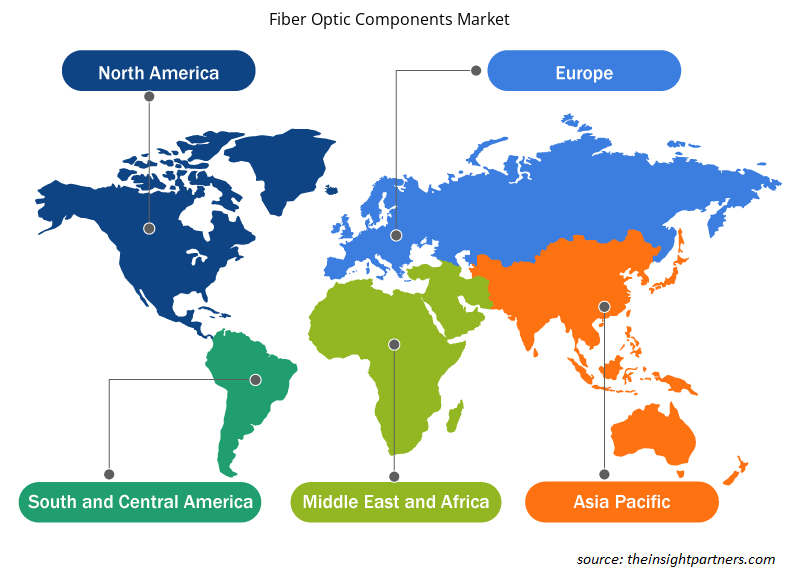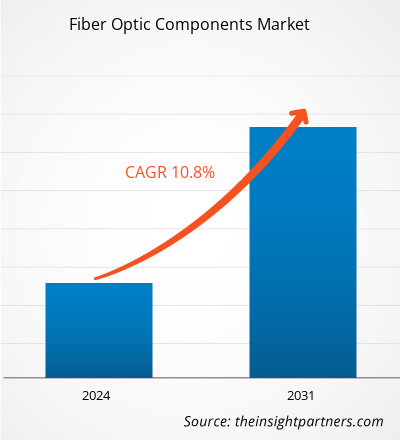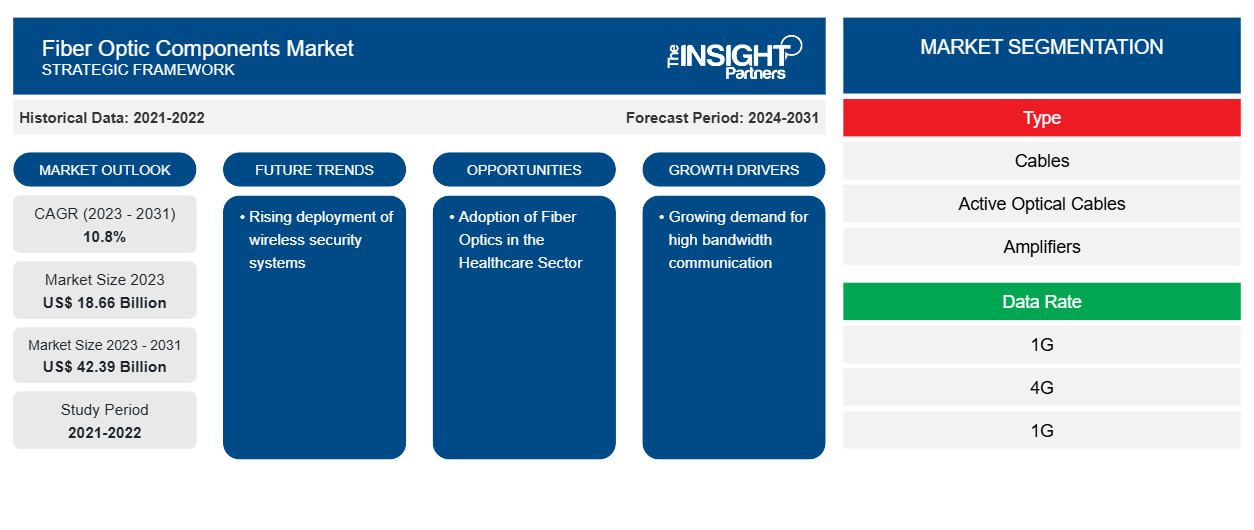世界の光ファイバー部品市場規模は、2023 年の 186.6 億米ドルから 2031 年には 423.9 億米ドルに成長すると予想されており、2023 年から 2031 年にかけて 10.8% の CAGR で拡大すると予想されています。ワイヤレス セキュリティ システムの導入増加は、光ファイバー部品市場の主要なトレンドであり続けると思われます。
光ファイバー部品市場分析
この市場の成長は、データセンターの展開の増加、インターネットの普及とデータトラフィックの拡大、帯域幅と信頼性に対するニーズの高まり、光ファイバーコンポーネントエコシステムの改善など、さまざまな商業上の理由によって推進されています。
光ファイバー部品市場の概要
一般的な光ファイバーは、光を運ぶコア、コアを囲んで屈折率が低く光を閉じ込めるクラッド、そして内部の繊細なファイバーを保護するコーティングという 3 つの主要コンポーネントで構成されています。光を運ぶコアは、光ファイバーの最小のコンポーネントです。光ファイバーのコアは通常ガラスで作られていますが、プラスチックで作られているものもあります。クラッドはコアを囲み、屈折率を下げて光ファイバーが機能できるようにします。ガラス クラッドを使用する場合、クラッドとコアは同じ二酸化ケイ素ベースの材料で作られ、永久に融合した状態になっています。コーティングは光ファイバーの保護カバーです。この層は、衝撃、切り傷、引っかき傷、さらには湿気さえも吸収し、クラッドを損傷する可能性があります。コーティングがないと、光ファイバーは非常に脆くなります。
要件に合わせてレポートをカスタマイズする
このレポートの一部、国レベルの分析、Excelデータパックなど、あらゆるレポートを無料でカスタマイズできます。また、スタートアップや大学向けのお得なオファーや割引もご利用いただけます。
-
このレポートの主要な市場動向を入手してください。この無料サンプルには、市場動向から見積もりや予測に至るまでのデータ分析が含まれます。
光ファイバー部品市場の推進要因と機会
高帯域幅通信の需要が高まり、市場が好調に
高速有線インターネットとブロードバンド ネットワーク インフラストラクチャのニーズが拡大しており、光ファイバー ケーブルの需要が高まっています。ゲーム、メディア、ビデオ ストリーミングなどの特殊なプログラム用の高速インターネット接続の必要性など、いくつかの要因がこのニーズに寄与しています。光ファイバー ラインは帯域幅容量が大きく、銅線よりも高速でデータを伝送できます。光ファイバー ケーブルは信号損失が少なく、電磁干渉の影響を受けにくいため、より信頼性が高く堅牢な通信が可能になります。
ヘルスケア分野における光ファイバーの導入
医療業界では、患者ケアと医療スタッフ間のコミュニケーションを改善するために、新しい技術の開発と採用が継続的に行われています。光ファイバー ネットワークは、最も信頼性が高く安全な接続を提供するため、この移行に不可欠です。この詳細なガイドでは、医療における光ファイバー ネットワークの利点、それが可能にする最先端技術、および業界のデジタル革命について説明します。医療業界は、光ファイバー インターネットとネットワークを主に採用しています。医療業界では、患者データが迅速かつ安全に配信されることを保証するために、高速で安全なインターネット接続に依存しています。また、光ファイバー ネットワークは、従来のインターネット接続よりも拡張性に優れています。scalable than traditional internet connections.
光ファイバー部品市場レポートのセグメンテーション分析
光ファイバーコンポーネント市場分析のタイプ、データレート、およびアプリケーションの導出に貢献した主要セグメント。
- タイプ別に見ると、市場はケーブル、アクティブ光ケーブル(AOC)、アンプ、スプリッター、コネクタ、サーキュレーター、トランシーバーなどに分かれています。ケーブル部門は2023年に大きな市場シェアを占めました。AOC), amplifiers, splitters, connectors, circulators, transceivers, and others. The cables segment held a larger market share in 2023.
- データレートに基づいて、市場は10G、40G、100G、100G以上に分割されています。2023年には100Gセグメントがより大きな市場シェアを占めました。
- アプリケーションに基づいて、市場は通信、分散センシング、分析および医療機器、照明に分かれています。通信セグメントは2023年に大きな市場シェアを占めました。
地域別光ファイバー部品市場シェア分析
光ファイバー部品市場レポートの地理的範囲は、主に北米、アジア太平洋、ヨーロッパ、中東およびアフリカ、南米/中南米の 5 つの地域に分かれています。2023 年、光ファイバー部品市場は北米が優勢でした。ワイヤレス技術、クラウド コンピューティング プラットフォーム、IoT ベースのセキュリティ システムの使用などの技術の進歩が、光ファイバー部品市場の成長を促進しています。これらの進歩により、無線通信システムの効率、利便性、有効性が向上します。IoT-based security systems, are propelling the growth of the fiber optic components market. These advancements improve the efficiency, convenience, and effectiveness of wireless communication systems.
光ファイバー部品市場の地域別分析
予測期間を通じて光ファイバー コンポーネント市場に影響を与える地域的な傾向と要因は、Insight Partners のアナリストによって徹底的に説明されています。このセクションでは、北米、ヨーロッパ、アジア太平洋、中東、アフリカ、南米、中米における光ファイバー コンポーネント市場のセグメントと地理についても説明します。

- 光ファイバー部品市場の地域別データを入手
光ファイバー部品市場レポートの範囲
| レポート属性 | 詳細 |
|---|---|
| 2023年の市場規模 | 186.6億米ドル |
| 2031年までの市場規模 | 423.9億米ドル |
| 世界のCAGR(2023年~2031年) | 10.8% |
| 履歴データ | 2021-2022 |
| 予測期間 | 2024-2031 |
| 対象セグメント |
タイプ別
|
| 対象地域と国 |
北米
|
| 市場リーダーと主要企業プロフィール |
|
市場プレーヤーの密度:ビジネスダイナミクスへの影響を理解する
光ファイバー コンポーネント市場は、消費者の嗜好の変化、技術の進歩、製品の利点に対する認識の高まりなどの要因により、エンド ユーザーの需要が高まり、急速に成長しています。需要が高まるにつれて、企業は提供内容を拡大し、消費者のニーズを満たすために革新し、新たなトレンドを活用し、市場の成長をさらに促進しています。
市場プレーヤー密度とは、特定の市場または業界内で活動している企業または会社の分布を指します。これは、特定の市場スペースに、その規模または総市場価値と比較して、どれだけの競合相手 (市場プレーヤー) が存在するかを示します。
光ファイバー部品市場で事業を展開している主要企業は次のとおりです。
- アクセリンクテクノロジー株式会社
- ブロードコム株式会社
- エムコア株式会社
- 富士通株式会社
- 古河電気工業株式会社
- 筋の通った
免責事項:上記の企業は、特定の順序でランク付けされていません。

- 光ファイバーコンポーネント市場のトップキープレーヤーの概要を入手
光ファイバー部品市場のニュースと最近の動向
光ファイバー部品市場は、主要な企業出版物、協会データ、データベースなどの一次調査と二次調査を経て定性的および定量的データを収集することで評価されます。以下は、市場の動向の一覧です。
- 富士通は2023年9月、光波1本あたり最大1.2Tbpsのデータを伝送できる光伝送技術を開発した。これは、容量25GBのブルーレイディスク6枚分のデータをわずか1秒間に転送するのに相当します。
(出典:富士通、プレスリリース、2023年)
光ファイバー部品市場レポートの対象範囲と成果物
「光ファイバーコンポーネント市場の規模と予測(2021〜2031年)」レポートでは、以下の分野をカバーする市場の詳細な分析を提供しています。
- 対象範囲に含まれるすべての主要市場セグメントの世界、地域、国レベルでの市場規模と予測
- 市場の動向(推進要因、制約、主要な機会など)
- 今後の主な動向
- 詳細なPEST/ポーターの5つの力とSWOT分析
- 主要な市場動向、主要プレーヤー、規制、最近の市場動向を網羅した世界および地域の市場分析
- 市場集中、ヒートマップ分析、主要プレーヤー、最近の動向を網羅した業界の状況と競争分析
- 詳細な企業プロフィール
- 過去2年間の分析、基準年、CAGRによる予測(7年間)
- PEST分析とSWOT分析
- 市場規模価値/数量 - 世界、地域、国
- 業界と競争環境
- Excel データセット
最新レポート
関連レポート
お客様の声
購入理由
- 情報に基づいた意思決定
- 市場動向の理解
- 競合分析
- 顧客インサイト
- 市場予測
- リスク軽減
- 戦略計画
- 投資の正当性
- 新興市場の特定
- マーケティング戦略の強化
- 業務効率の向上
- 規制動向への対応























 無料サンプルを入手 - 光ファイバー部品市場
無料サンプルを入手 - 光ファイバー部品市場